
An overview of traffic flow and construction on Section 2 of the Nairobi Expressway Project along Mombasa road. /Getty
An overview of traffic flow and construction on Section 2 of the Nairobi Expressway Project along Mombasa road. /Getty
Editor's note: Stephen Ndegwa is a Nairobi-based communication expert, lecturer-scholar at the United States International University-Africa, author and international affairs columnist. The article reflects the author's opinions, and not necessarily the views of CGTN.
With the launch of the 14th Five-Year Plan period (2021-2025) for National Economic and Social Development and the Long-Range Objectives Through the Year 2035 during the plenary session of the 19th CPC Central Committee in Beijing last week, China has once again stamped its vision and commitment toward building a moderately prosperous society in all respects.
Subsequently, China has entered the penultimate stage toward achieving developed country status through its overall 15-year roadmap toward modernization. Details of the blueprint are contained in a communiqué released on October 29 after the four-day meeting.
The major planks of the strategy encompass aspects like innovation and technology, industrialization, rural vitalization, real economy, a strong domestic market, environmental conservation through eco-friendly ways of work and life, and strengthening the country's culture, education, talent, sports and health.
African economic experts are now identifying, suggesting and analyzing areas of mutuality and commonality between the continent's development needs and China's new path. Moreover, Africa now needs to rev up its pace of social and economic development in order to reap maximum benefits from China's increased development momentum. As the biggest developing country, China's unprecedented success has great lessons and inspiration for the largest developing region.
In an article, "Five-year plan holds promise for Africa", senior associate fellow of the Nairobi-based China-Africa Center observed that the plenum "opens up opportunities for collaboration and cooperation with African countries in areas such as manufacturing, transportation, public health, agriculture and communication."
Even in cases where there are no direct linkages between the two partners, the expert notes that the technological innovations touching on green energy can be part of the economic and technological cooperation, which would help to fill the continent's energy gap. This can still be stretched further to show how the foregoing will help Africa achieve the United Nations Sustainable Development Goals.
There are two levels which Africa can plug into China's five-year program - bilateral and multilateral. Bilaterally, China has individualized partnerships with the majority of African countries, with each country on a different page depending on its current and unique development needs.

An ocean rolling ship is at berth 68, ready to load more than 1,500 vehicles for export to Egypt, in Lianyungang City, east China's Jiangsu Province, October 11, 2020. /Getty
An ocean rolling ship is at berth 68, ready to load more than 1,500 vehicles for export to Egypt, in Lianyungang City, east China's Jiangsu Province, October 11, 2020. /Getty
Therefore, while some countries will give more weight to innovation to establish their fledgling digital economies, others might find rural vitalization as the best way to develop their agricultural based economies. Some countries have urgent infrastructural needs while others need to immediately plug into China's established public health sector, especially now that the world is struggling to contain the coronavirus pandemic.
However, the real deal is in the Forum on China-Africa Cooperation (FOCAC), the collective partnership vehicle comprising 53 African countries that have established diplomatic relations with both China and the African Union Commission.
China's blueprint basically resonates with the partnership areas of the 20-year-old FOCAC. These include agriculture and food security, industrialization, investment and enterprise, infrastructure, trade, finance, energy and natural resources, climate change, poverty reduction, public health, education and, peace and security. Further to the foregoing, plugging into China's fifth plenum can help Africa satisfy its unmet development objectives and priorities in these key sectors.
The recent establishment of the African Continental Free Trade Area (AfCFTA) agreement drives Sino-Africa relations even closer. The continent can benefit from China's strategy of giving more impetus to growing internal demand as a way of reducing reliance on international trade.
Africa also needs to become bolder and venture into non-traditional areas of cooperation, mainly in culture and governance. Although there are some ongoing cultural exchanges, there is need to deepen and extend this to aspects like language and the arts with the aim of creating more mutual understanding and appreciation between the two partners.
Politically speaking, Africa's history places it in an ideal position to adopt a modern socialist system with African characteristics. This entails developing the interdependence between the individual and the State to help both achieve their potential. This could be the missing link in the continent's full development as the current liberal democratic system in most of the countries has led to massive wastage of time and resources.
The launch of the 14th Five-Year Plan has also given hope to Africa of continuity beyond COVID-19. China is one of the few countries whose economy is back on track amid the devastation caused by the pandemic in many other countries whose economies have either stagnated or regressed. China would be ready to share the strategies that it applied to gird it from external shocks and use the misfortune as a catalyst for restoration and growth.
(If you want to contribute and have specific expertise, please contact us at opinions@cgtn.com.)